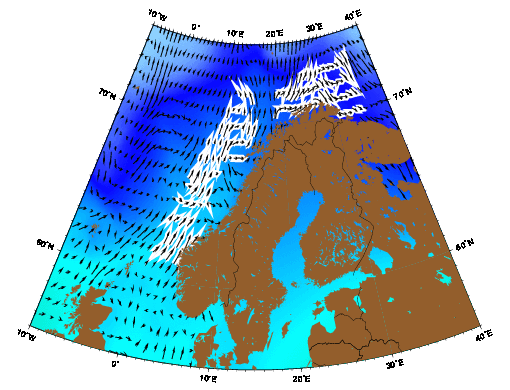
| ||
| The Norwegian current as represented by the Mariano Global Surface Velocity Analysis (MGSVA). The Norwegian current has an offshore branch and a coastal component that hugs the coast of Norway. It transports relatively warm, saline waters into the Arctic Ocan and this influences the amount of winter-time convection and water mass formation. Click here for example plots of seasonal averages. | ||
Estimates for the velocities of the current vary widely. With current meters at 25 m depth, Haugan et al. (1991) measured large temporal and spatial variations in the current, ranging from 5 cm s-1 to 60 cm s-1. To them, this suggested a characteristic speed of 30 cm s-1. Danielssen et al. (1997) found that the velocities varied greatly with time. During the first part of their experiments, the current exhibited velocities ranging from 10-40 cm s-1. Then, after 5-6 June, they recorded velocities up to 100 cm s-1 as a clear barotropic current component developed. Moorings deployed during the Norwegian Continental Shelf Experiment (NORCSEX '88) detected current velocities of 7 cm s-1 to 20 cm s-1 with a mean northeastward direction (Haugan et al. 1991). The direction was almost parallel to the isobaths, indicating significant topographic steering (Haugan et al. 1991).
At the central Norwegian shelf, the bottom topography is complex and involves shallow banks separated by deep trenches. Topographic steering plays a major role in shaping circulation patterns in the area (Saetre 1999). For example, the topography causes the current to split at about 63°30'N (Ljoen and Nakken 1969). The outer minor branch follows the continental shelf break, and the inner major branch resembles a coastal jet (Saetre 1999). The outer branch mixes with Atlantic Water and eventually loses its identity, making it difficult to detect north of 65°N. The inner branch is the wedge-shaped portion, and it flows in a narrow 20-30 km wide zone (Saetre 1999). The topography also influences direction and stability. The Norwegian Current generally follows the Norwegian Trench, the deepest feature in the North Sea (Johannessen et al. 1989). The depth of the trench, along with density differences between Norwegian Current water and the adjacent Atlantic Water, result in eddies of scales that are much greater than in most sea shelf fronts (James 1991).
Mesoscale eddies and meanders in the Norwegian Current have been studied using remote sensing and in situ observations. Most observations indicate that they have wavelengths of 50-100 km and northward velocities of 10-20 cm s-1 (Johannessen and Mork 1979, Audunson et al. 1981, Mork 1981, Ikeda et al. 1989). Using combined Acoustic Coppler Current Profiler, towed, undulating CTD, and satellite infrared data, Johannessen et al. (1989) found that the cyclonic eddies were highly asymmetric, had significant barotropic components, and extended to the bottom. Based on these observations, they concluded that the combined effects of topographic steering, vortex stretching, and barotropic instability explained the generation of eddies between 60°N and 61°N. Meanders and eddies generated upstream by baroclinic instabilities grow and also enter this region. The resulting interactions complicate the eddy field (Johannessen et al. 1989).
An important aspect of the Norwegian Current is its effect on the ice cover in the Barents Sea. Compared with the cold and fresh Arctic water, the waters of the Norwegian Current are relatively warm and saline. The exchange of heat between these two water masses is enhanced during years with a positive NAO (North Atlantic Oscillation) pattern (Dickson et al. 1996, Venegas and Mysak 2000). Under these conditions, the transport of heat by the Norwegian Current into the Arctic region is stronger than normal. When the NAO is negative, Atlantic waters do not penetrate so far north, and ice is easily formed and maintained in the Barents Sea. This mechanism, which is closely tied to atmospheric variations, operates on quasi-decadal time scales (Venegas and Mysak 2000). Another mechanism that influences ice variability in the Barents Sea is the changes in the upper-ocean temperature of the Atlantic waters that the Norwegian Sea carries. These changes are probably related to the advection of sea surface temperature anomalies by the subpolar and/or subtropical gyres (Grotefendt et al. 1998, Venegas and Mysak 2000). Dependent mainly on the advection time of the ocean gyres, this mechanism has a longer period of oscillation than the first (Venegas and Mysak 2000).